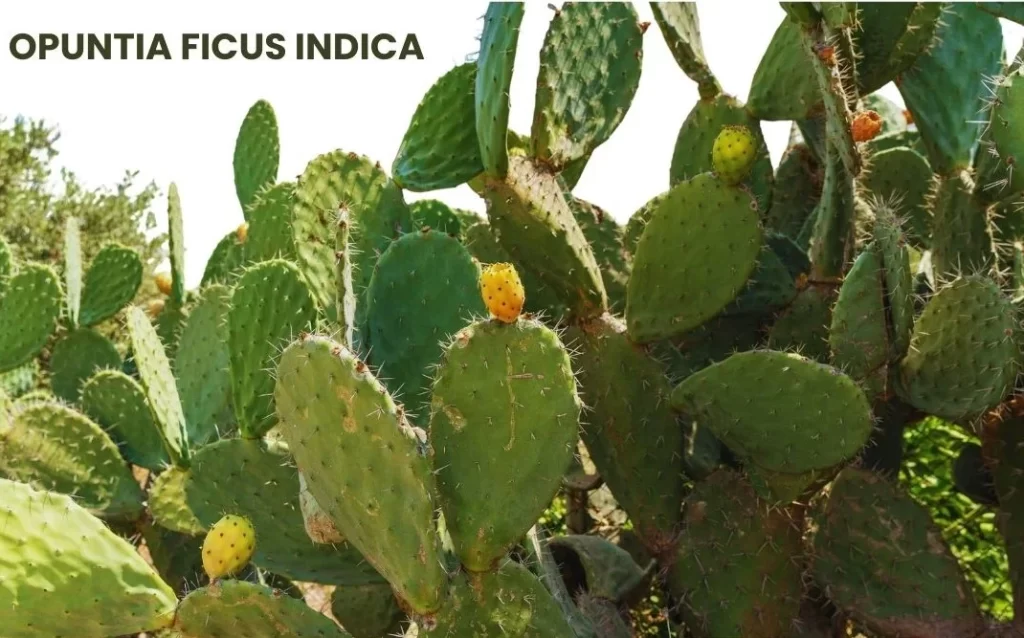Opuntia Ficus-Indica, commonly known as Prickly Pear, is a homeopathic remedy derived from the fruit of the Opuntia Ficus-Indica Cactus.

Table of Contents
ToggleSOURCE INFORMATION
Scientific Classification
- Kingdom: Plantae
- Order: Caryophyllales
- Family: Cactaceae
- Genus: Opuntia
- Species: Opuntia ficus-indica
Opuntia ficus-indica, commonly known as Prickly Pear, is a homeopathic remedy sourced from the fruit of the Opuntia ficus-indica cactus.
Opuntia ficus-indica, also known as the Indian fig opuntia, Barbary fig, or cactus pear, belongs to the Cactaceae family.
This species of cactus is native to Mexico and other regions of the Americas but has been naturalized and cultivated in various arid and semiarid regions worldwide.
The fruit of the Opuntia ficus-indica cactus, known as prickly pear or cactus pear, is used to prepare the homeopathic remedy.
Harvesting and Preparation
- The ripe fruit of the Opuntia ficus-indica cactus is harvested when it reaches maturity.
- The fruit is characterized by its oval shape, prickly skin, and vibrant colour, ranging from yellow and orange to red and purple, depending on the cultivar.
- To prepare the homeopathic remedy, the ripe fruits are carefully collected and processed according to homeopathic principles.
Processing Method
- The processing of Opuntia ficus-indica for homeopathic use involves a series of dilutions and succussions (vigorous shaking) to potentize the medicinal properties of the fruit extract.
- The fruit extract is diluted in alcohol or water and succussed to create various potencies of the remedy, which are then used for therapeutic purposes.
Interesting Facts
- Prickly pear fruits have a long history of traditional medicinal use in indigenous cultures, particularly in Mexico and other parts of Latin America.
- In addition to its therapeutic properties, prickly pear fruits are also consumed fresh or processed into various culinary products, such as jams, jellies, candies, and beverages.
- Opuntia ficus-indica is valued for its resilience in arid climates and is often used in agroforestry and land reclamation projects to combat desertification and soil erosion.
KEY CHARACTERISTICS
- Diarrhoea with nausea: Opuntia ficus-indica is indicated for diarrhoea accompanied by nausea, where the individual feels as if the bowels have settled down in the lower abdomen.
- Sick feeling in the lower third of the abdomen: Individuals may experience a sensation of sickness or discomfort localized in the lower abdomen.
- Enteroptosis with loose and frequent evacuations: Opuntia ficus-indica is also useful for cases of enteroptosis (prolapse of the intestines) with loose and frequent bowel movements.
MODALITIES
- Symptoms may worsen with certain dietary factors or emotional stress.
- Improvement may be observed with rest and relaxation.
RELATIONSHIP WITH OTHER DRUGS
Compare with Chaparra amargosa and Ricinus communis for similar indications in chronic diarrhoea and dysentery.
DOSE
Opuntia ficus-indica is typically administered in the second attenuation.
Frequently Asked Questions
What is Opuntia ficus-indica?
- Opuntia ficus-indica, or Prickly Pear, is a homeopathic remedy derived from the fruit of the Opuntia ficus-indica cactus.
What are the key indications for using Opuntia ficus-indica?
- It is primarily indicated for diarrhoea with nausea, a sick feeling in the lower abdomen, and enteroptosis with loose and frequent evacuations.
How is Opuntia ficus-indica prepared?
- The ripe fruit of the Opuntia ficus-indica cactus is used to prepare the homeopathic remedy through a process of potentization.
Meaning of Difficult Words
- Diarrhoea: A condition characterized by frequent, loose, or watery stools.
- Enteroptosis: Abnormal downward displacement or prolapse of the intestines.
- Nausea: A sensation of discomfort or queasiness in the stomach, often preceding vomiting.













Leave a Reply